Resistance to negative climatic conditions
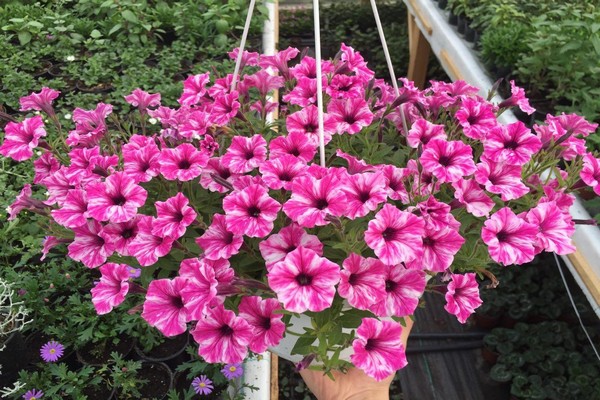
Most petunia varieties struggle with bad weather conditions. In windy weather, the petals of the plant almost open from the stem, and in rainy weather, the shape of the petunia is lost. In the rain, it is recommended to hide containers with plants under a canopy. But such a measure is not always practical and convenient.
The Surfinia variety does not suffer from bad weather, it does not need to be covered with anything. The only thing that can be done is to remove the leaves that have been spoiled by the rain. The flower is able to grow new petals in a short time. From such a process, petunia will not lose its beautiful appearance.
The variety is considered to be an ampelous variety, but it is very easy to confuse it with other varieties.
Varieties of petunias. How to understand their diversity?
Petunia, an amazingly beautiful flower from the genus Tabaka, is very popular with gardeners. Now, numerous hybrids of this garden culture are used for breeding. All varieties of petunias are divided into several large groups, within which there are many different varieties. The division into groups is based on differences in size and external characteristics of the plants.
By shape, plants can be divided into bushy and flowing, or ampelous.
Bushy petunias are divided into several groups by flower size:
- Petunia Grandiflorum (Grandiflora). This group is especially popular. It includes varieties of petunias with very large flowers (up to 12 cm) of the most fantastic colors. More than one hundred varieties and various hybrids belong to grandifloras. For example, there are varieties such as Grandiflora Stunted, Superior, Large Terry, etc. Large-flowered petunias are especially good for container breeding.
- Petunia Multiflorum (multiflora) are multi-flowered varieties with a whole sea of not very large, but unpretentious, resistant to rain, wind and other climatic features of the middle band of flowers. The average diameter of flowers in these varieties is about 5 cm, they are smooth, simple. They are suitable for growing in hanging baskets or creeping on the ground.
- Petunia Floribunda. It is a transitional form between multi-flowered and large-flowered petunias. Its flowers are larger than those of multi-flowered ones. Some varieties of petunias of this form have double flowers, some are simple.
- Petunia Milliflorum (small-flowered) - has flowers no larger than 2.5 cm. It is rain-resistant, undersized (no more than 15 cm) variety.
Petunia ampelous differs from bush in longer hanging, falling stems more than a meter long. Varieties of this group are planted in hanging pots, in boxes on balconies, or they decorate the slopes of an alpine slide. Among them are the following groups:
- Calibrachoa - small-flowered varieties of petunias with long hanging shoots, propagating only vegetatively.
- Surfinia, the flowers of which can reach 8 cm. Reproduction is also only vegetative.
- Cascading petunias, or supertunias. They can be propagated both by seeds and vegetatively. All three varieties have a special decorative effect.
- Among ampel petunias, semi-ampelous ones are also distinguished, with less long stems.
The newest varieties of petunias are characterized by unusual colors. For example, in England in 2011, a variety with black petals was bred. This is the first such plant among petunias. The name of the variety is Black Velvet.
Among the new floribundas, one can note the abundant flowering petunia F1 Niagara Falls, which is characterized by a beautiful appearance, large, up to 7 cm, satin flowers of various colors, friendly flowering and unpretentiousness.
Among the new large-flowered varieties of petunias, the F1 hybrid Ostrich feather is good, with unusually large spherical flowers with a jagged edge. When grown in a flowerbed, a plant of this variety is capable of creating a flowering carpet with a diameter of one and a half square meters. This hybrid is perfect for growing in pots, balconies and baskets.
It is difficult to single out the best varieties of petunias, because each is good in its own way, and they are all very beautiful. So, among ampel petunias, such not new varieties as Lilac surf, amazing Pearl surf, Waterfall have proven themselves well. Among the calibrachoa, the Calibrachoa Million is distinguished, which creates whole waterfalls of medium-sized, but beautiful flowers.
When buying petunias for breeding, you need to pay attention to the shape of the bush. It depends on which landing it is better to use them.
When propagating by seeds, only the seeds of F1 hybrids should be taken. If you want to get plants with the same appearance next year, use vegetative propagation of these flowers by cuttings.
.
Description of culture
The culture is a hybrid of the well-known petunia. This unique plant differs from the basic varieties by its powerful two-meter shoots, decorated with a "waterfall" of large flowers. Depending on the method of planting the plant, its shape can be different. A ball or a spectacular cascade is the choice of the grower.
Surfinia appeared as a result of attempts by breeders from Japan to adapt petunia to unfavorable weather. As a result, this large-flowered ampelous variety appeared. It propagates only by cuttings.
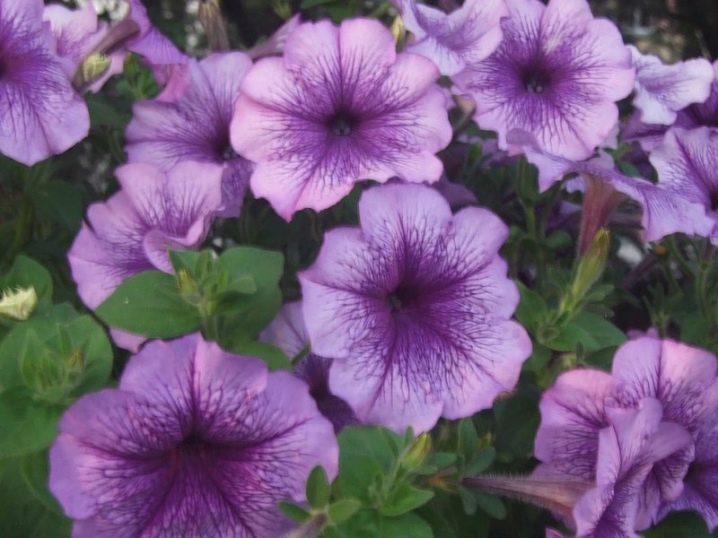
The flowers of the plant reach a diameter of 9 cm. The color can be either one-color or combined. Usually, the pharynx stands out against the background of the general shade. Contrasting streaks or fringes can give flowers a vibrant personality. Petals can be either regular or terry.
Features of the hybrid:
- resistance to any climatic conditions (neither rain nor strong wind can damage the beauty of the bushes);
- early and long flowering, pleasing with an abundance of beautiful buds;
- a wide variety of varieties, and therefore shapes and shades of flowers;
- excellent immunity that protects against diseases and pests;
- fast growing season (surfiniya can become a full-fledged plant in a couple of months).
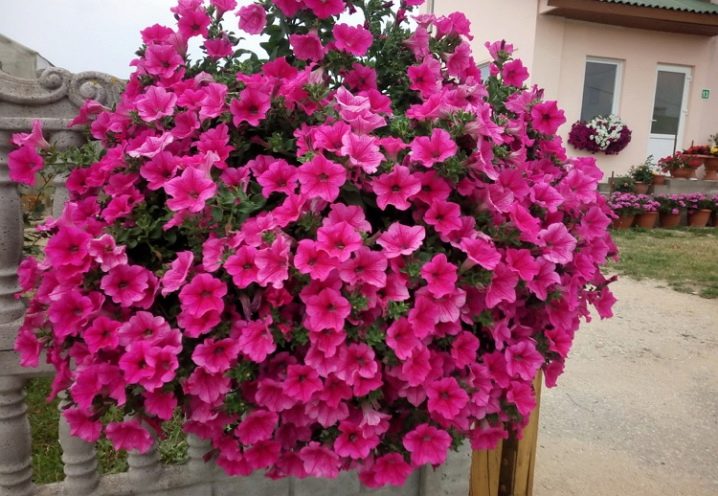
Features of plants
All modern cultivated varieties of petunia are obtained as a result of hybridization of wild species originating from South America, and differ in a variety of colors and shapes.
Petunia
Petunia belongs to the nightshade family, belongs to the genus of perennial herbaceous plants, but is grown primarily as an annual. Hybrid varieties are famous for their high level of decorativeness, and the intensity and duration of their flowering largely depend on soil and climatic factors and competent care. Plants are propagated generatively () or vegetatively (cuttings).
Depending on the type of shoots, the shape and size of the bushes, varieties are divided into two types:
- bushy (or bush, upright) - with straight shoots from 15-20 cm long (undersized) to 80 cm, developing in the form of dense compact bushes-pillows;
- hanging (or creeping, ampelous) - with long shoots covering a large area. With horizontal gardening, they are used as ground covers, and with vertical gardening in hanging containers (pots), they fall in a cascade. The differences between cascading petunias and ampelous ones are conditional, therefore they are often considered as a single species, highlighting cascading (or semi-ampelous) petunias in a separate category or group.
Among the bush varieties, varieties with luxurious double flowers have gained particular popularity.
Ampel petunias are distinguished by several parameters that characterize the shape, color and size of flowers. According to the commercial classification, categories or variety groups with improved decorative characteristics are distinguished among them, for example, surfinia, supertunia, fortunia and others.
Surfinia
Surfinia, registered as a trademark, belongs to the collection of F1 Surfinia hybrids, bred by breeders of the Japanese company "Suntory". This varietal group of ampel petunias is distinguished by excellent branching, since shoots develop from all internodes and a high growth rate. Creeping on the soil or hanging (drooping) powerful lashes can reach a length of about 2 meters.
Surfinia quickly grows in the form of a cascade, a pillow and even a ball - it all depends on the method of planting and forming the plant, it blooms actively throughout the season
These hybrids also have increased endurance and resistance to adverse weather factors, providing early, long and abundant flowering (from May to autumn cold weather). The flowers, located along the entire length of the shoots, are of medium (5-6 cm in diameter) or large (8-10 cm in diameter) sizes. Their shape is mostly classical in the form of "bells" or "gramophones" with a smooth surface and edges. Flowers can be double or velvety, predominantly white, blue and pink in color. The seeds in them ripen in very small quantities or do not set at all, therefore the main method of reproduction is vegetative, with the help of cuttings.
The surfinia root system is very powerful. For its full development, when grown in individual containers of the substrate, a volume of at least 8 liters is required per plant.
Surfinia has many varieties, which, according to the reviews of amateur flower growers, almost all are successfully grown in garden plots. The most popular are the following varieties:
Burgundy (Surfinia Burgundy) is a compact, but at the same time massive and densely branching bush with abundant flowering, large flowers (8 cm in diameter) of a rich wine color
Hot Pink (Surfinia Hot Pink) - has large flowers of bright pink color with pronounced crimson veins running from the throat to the wavy edge of the flower
Table White (Surfinia Table White) - has snow-white flowers in the form of bells, which densely cover the entire bush. The flowering period lasts from May to the coldest months
Elo (Surfinia Yellow) is one of the first ampelous petunia hybrids. This variety has flowers of a pale yellow color, early and abundant flowering
Double Purple (Surfinia Double Purple) - double petunia with bright purple flowers. The variety is characterized by strong growth and resistance to excess moisture in summer.
Red (Surfinia Red) is a very beautiful variety that has won many awards at various exhibitions. Its flowers are painted in a rich, perfectly pure scarlet color.
How to distinguish from petunia?
The beautiful annual plants of the ampelous type include petunia and surfinia. What is the difference between these beauties? The differences are noted for the following features:
- At the seedling stage, flowers are distinguished by their ability to branch and grow. Even at the level of sprouts, it was noticed that the seedlings of petunias are much smaller than those of surfinia, although they are of the same age. Petunias have a meager number of side shoots, compared to surfinia. Petunia shoots tend upward. Surfinia has a lot of shoots; in pots, at first they grow to the sides and resemble a giant colorful spider, then they hang down in garlands.
- Here's another difference - petunia and surfinia, as adult plants, form their bush in different ways. To grow a luxurious crown of petunia flowers, a person should come to the rescue. It is required to pinch the shoots that have grown on the sides, thus activating branching. First, the plant should be green, and only then bloom. Only in this way, and not otherwise, you will get a beautiful green petunia hat, decorated with flowers. With surfinia, things are easier. She herself will direct her processes, and the space allotted to her will be filled with flowers and their aroma.
- Although relatives and close ones, their breeding method is far from each other. Petunia can be propagated by cuttings and produces seeds. Surfinia for seeds is "greedy", so the vegetative method is used for reproduction.It is enough just to cut the cutting off the bush and transplant it into the ground. In order for the cutting to take root, this must be done faster.
- What is the difference between petunia and surfinia yet? They can be compared by the bushes and flowers themselves. Petunia is a small plant that usually grows in boxes on balconies or lawns. Surfinia has a more lush and rich flowering, it is planted in large baskets and outdoor flowerpots, at a good distance from each other.
Despite the exquisite beauty of surfinias, petunias should not be discounted. Breeders have developed new mini-varieties that will delight the eye and decorate the summer cottage with their flowering. The species with amber flowers is in demand. Unlike a simple petunia, it will compete even with surfinia.
In addition to the indicated signs, it will not work to find the difference between surfinia and petunia, since it is no longer there. They have similar flower shapes, sizes and color palettes.
Surfinia ampelous - a hybrid of petunias
Surfinia ampelous are a special hybrid of petunias. The colors of their large buds, up to six centimeters in diameter, are very diverse.
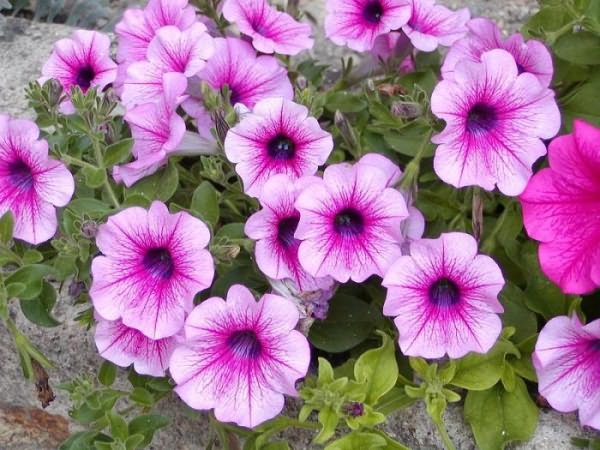
The main thing that distinguishes these flowers from petunias is that ampelous surfinia do not produce seeds.
They are very light-requiring, although they tolerate slight darkening well. In addition, they are very thermophilic and grow better on slightly acidic light soils.
After the onset of rainy weather or a slight drop in temperature, the flowering of these petunia hybrids is suspended in order to resume again with the return of good weather.
Surfinia ampelous, the cultivation of which does not require much effort and is within the power of even a beginner grower, is a fairly drought-resistant plant. However, regular watering has a very beneficial effect on the splendor of the flowering.

Plants should be planted immediately in large pots or boxes, since after a while they form into rather large hanging bushes.
The substrate is selected with weak acidity, loamy or sandy, although flowers grow quite well on other fertile soils. Adult ampelous surfinia need good feeding and constantly moist soil. Therefore, it is better to hang the pots so that they are well protected not only from the direct sun, but also from the wind.

This hybrid of petunia propagates, as a rule, by cuttings, which is better to start in August, so that a young plant grows in the pots by winter.
When growing seedlings, it is better to use additional lighting so that daylight hours last at least sixteen hours.
Cuttings are chosen apically and with a length of about eight centimeters. The lower leaves are removed. Seedlings are watered with moderately warm water. The ambient temperature should be 26 degrees on average.
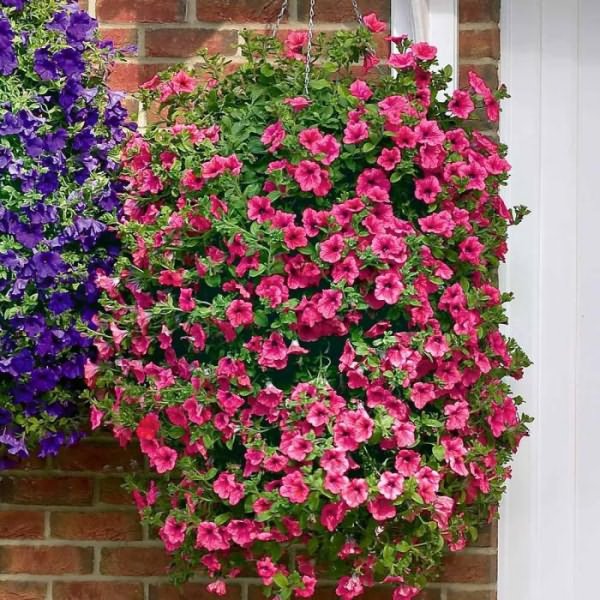
Surfinia ampelous, like any petunias, are perennials. They hibernate in cool rooms where the temperature does not drop below five degrees. Plants fall into a "slumber", do not bloom and do not release new leaves, but in the spring they wake up and may even put out buds.
When laying them for the winter, you need to cut off all long lashes so that the bush after waking up is fluffy and symmetrical.
Surfinia ampelous, the photo of which is very reminiscent of a colorful bright ball, can get sick with improper care. This can happen with too much watering, which will provoke wet rot. In this case, all darkening must be removed, and the soil must be treated with a special preparation.
Often, surfinia lashes are affected by late blight, for the prevention of which, the stems can be treated with copper-containing substances.
.
In the flower market, petunia occupies one of the main places, as it has a very attractive appearance. Flowers come in various shapes and colors, besides, they touch the strings of smell with a mild aroma.
Among the variety of varieties, one of the most striking, spectacular and often grown by gardeners is petunia Surfinia. It belongs to the ampelous varieties. Japan is her homeland.The delicate tastes of Japanese breeders have been embodied in the image of this flower, and for more than 20 years people have been able to contemplate the unique beauty of the plant.
As noted by experts and summer residents who grow Surfinia flowers at home, this hybrid does not lose its decorative component in strong wind and rain.
Among the advantageous characteristics, it should be noted resistance to many diseases and pests. The peculiarity of the variety is that its flowers have a lush, rich flowering.
Varietal traits
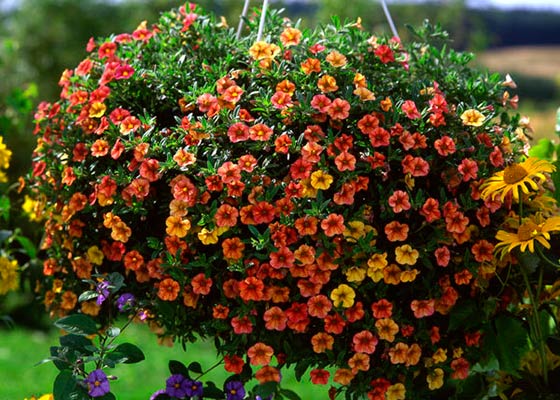
Petunia surfiniya belongs to numerous hybrids of bush petunias, in contrast to which it has long stems. Varietal traits allow a florist to immediately distinguish an ampelous plant from other species. The lateral erect stems of surfinia, in the process of growth and the appearance of flowers, go down, creating a colorful waterfall.
For a long time, breeders have tried to create petunia hybrids with the help of crossing, which would have resistance to pests and diseases. The result exceeded the wildest expectations.
The best representatives of surfinias are:
- Salmon corduroy. Delicate pink or bright purple flowers grow abundantly on shoots reaching a length of 80 cm.
- Burgundy. The deep maroon color is associated with fine wine. Hence the original name of the hybrid.
- Deep Purple The lush bushes of the plant are adorned with many purple double flowers.
- Table White. The snow-white bell flowers are pleasing to the eye from spring to the first severe frosts.
- Parple corduroy. The hybrid has the longest branches - 1 m. The petals of the flowers are purple in color, the core is dark.
Petunia is an annual in design
Petunia flowers are attractive in a variety of colors and shades from delicate white, pink, to purple and blue with veins. Flower growers are delighted with bright buds on balconies and in gardens all season long.
Annual petunias are used in landscape design of various types:
Multi-flowered, with many small flowers. They bloom all season. When landscaping summer cottages, they are liked for their unpretentiousness to the ground, they tolerate direct sunlight, rains and winds. Their lush multicolor dazzles in the gardens all autumn.
Large-flowered. They have more than a hundred varieties. There are few flowers, but they are large. There is one drawback - it's fragility. Flowers are not resistant to wind, rain, they lose their decorative appearance. Therefore, large petunias are planted, as a rule, on balconies and terraces.
Ampel species have long stems that grow downward. These flowers go well with begonias in flower beds and flower beds. The ampelous views in hanging pots and baskets are especially beautiful. Flowering begins in July and lasts until cold weather.
Care
In practice, the formula for growing petunias is large containers, frequent feeding and abundant watering, as well as removing faded parts.
Seed propagation
The seeds are mixed with sand, scattered on the soil, and then lightly watered, covered with a film. After a week, sprouts will appear, which need to be sprayed with water twice a day. Sometimes sprayed with potassium permanganate. When the first leaf appears, the film is removed, and the soil is sprinkled with sand, watering is reduced. With the growth of 3-4 leaves, they are picked, seated separately.
Planting tanks
The roots of petunias are quite strong, and a lot of soil is required. About one bush needs about 5 kg of soil. You can plant 2 flowers in one container of 10 liters. And in a box on a loggia 1 meter long - no more than three.
The need for frequent feeding
They begin to feed them half a month after the pick. First you need to include more nitrogen for fast growth.
Later, phosphorus and potassium are needed for budding. Foliar dressing is good with trace elements. With a lack of iron, the leaves begin to turn yellow. This can be corrected by adding iron chelate. Processing is carried out 3-4 times with an interval of 5-6 days. Adult petunias are fed every 5 days, alternating foliar and root feeding.
Top dressing of adult plants should have a lot of phosphorus, which helps root development.If you give more potassium to young bushes, then the plant will be weak, with thin roots.
They also add special complexes with vitamins and minerals, which stimulate root formation, helping to adapt when changing temperatures and humidity. When feeding, you can spray the leaves with them for better growth.
Watering
It is very important not to overmoisten the seedlings, as they can get sick with a black leg. Adult flowers need to be watered abundantly.
But short-term lack of moisture is well tolerated. When watering, you need to let the soil dry out.
Removal of faded parts
This should be done regularly to stimulate a bloom burst. But if it is weak, then you can cut off the seed pods and apply fertilizer.
If you want the petunia to thicken, and not stretch into one stem, you need to pinch it over the 3rd leaf.
Caring for petunia on the balcony
- If the windows face south, then the petunia will bloom all season. But on the north side there will be more green mass than buds.
- In order for the bush to grow compactly and not be tall, it needs to stand in the cold at night and warm during the day.
- In order for the plant to become bushy, and not in one trunk, it must be pinched after two pairs of true leaves.
- Roots grow faster in cool soil. But if the soil is warm, then the bush should receive a lot of light - then the seedlings develop magnificently.
Leaves curl if a spider mite is introduced. Many holes also appear on them. Leaf curling occurs in dry air in hot weather.
The plant blooms for a long time during long daylight hours.
If the plant has little light, then it may not bloom at all.
Ampel species need to provide a large volume of soil. Then the vines grow long and lush.
The most popular are the following varieties:
Landing
Surfinia prefer neutral or slightly acidic soils, light, with high water and air permeability. The optimal substrate can be purchased ready-made, or you can make it yourself, for this, peat and vermiculite are combined in equal proportions, then sod soil is introduced in a 1: 2 ratio, and in order to give the soil mixture the necessary looseness, a little vermiculite is added to it. In order to bring the pH to the required parameter of 6.5, you need to add a little crushed coal or lime to the substrate.
Surfinia seeds must be sown at the end of February, after which the sprouts are moved into small containers with a diameter of 10-12 cm. However, the seedlings obtained in this way are quite sensitive to external factors and therefore become susceptible to fungal infections. As a rule, in amateur conditions, it will not work to grow surfinia in this way, therefore the easiest way is to purchase ready-made seedlings for growing in open ground, pots and garden boxes.
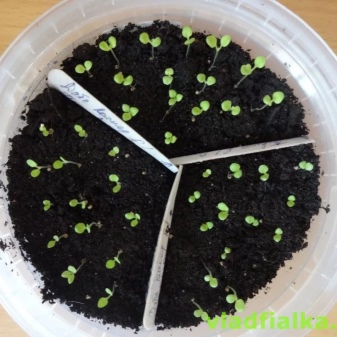

Varieties
Consider the most famous and popular surfiniya varieties.
Yellow. This variety was one of the first to be created. Amazing light yellow flowers conquer with their tenderness. The variety is resistant to low temperatures, due to which it pleases with flowering until the very frost.
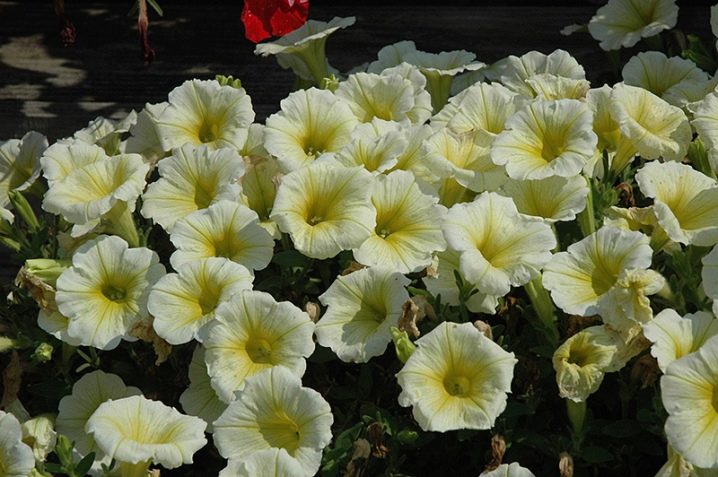
Double Purple. Bright purple flowers adorn the bushes of this variety. The culture grows and develops rapidly and is resistant to moisture.
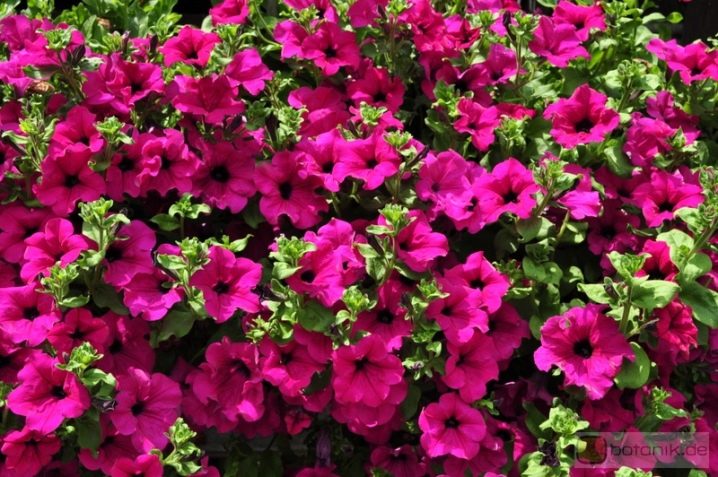
Red. Compact bushes in the shape of a ball, strewn with large rich red flowers, become a real decoration of any garden. Flowers appear early and delight the gardener for a long time.
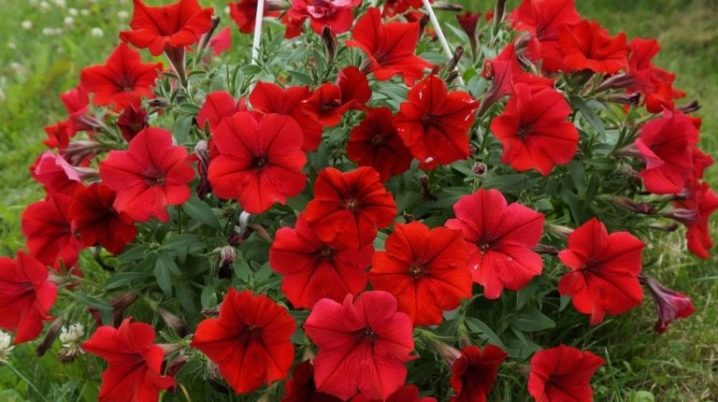
Heavenly Blue. The tall and strong bush has long shoots. The plant is covered with blue, sometimes lilac flowers.
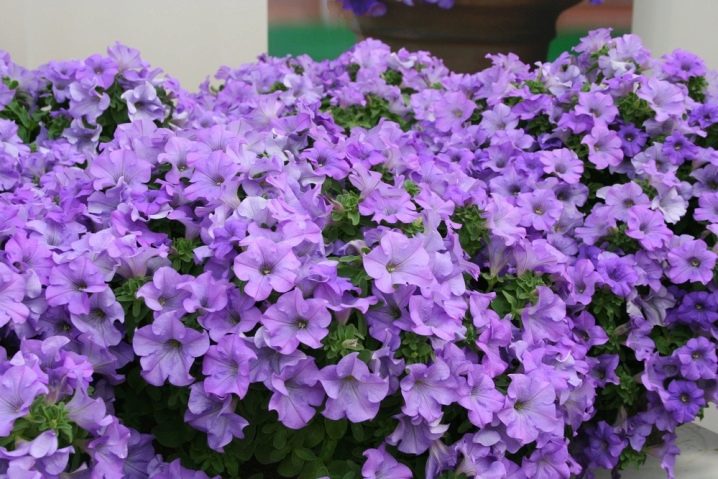
Coral Morn. Bright pink flowers with a white center and rounded petals will undoubtedly appeal to women. Such a romantic decoration will transform any gazebo or flower bed.
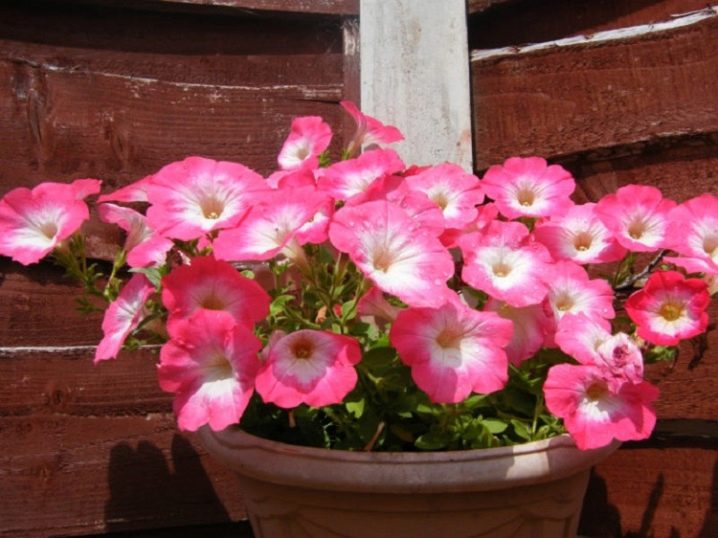
Green Edge Purple. This variety is characterized by an unusual combination of shades. Pink petals with light green edges surprise and delight. A neat but powerful bush pleases with abundant flowering and dense foliage throughout the warm season.
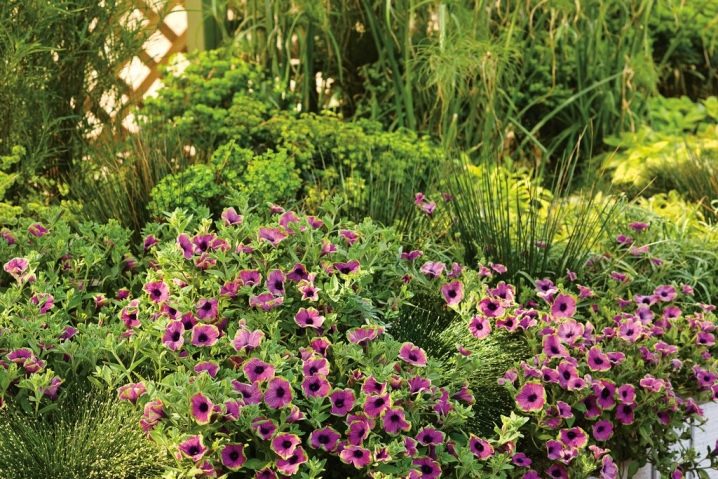
Table White. It is an early variety with high decorative qualities. Its flowering lasts almost six months. Snow-white flowers resembling bells leave no one indifferent.
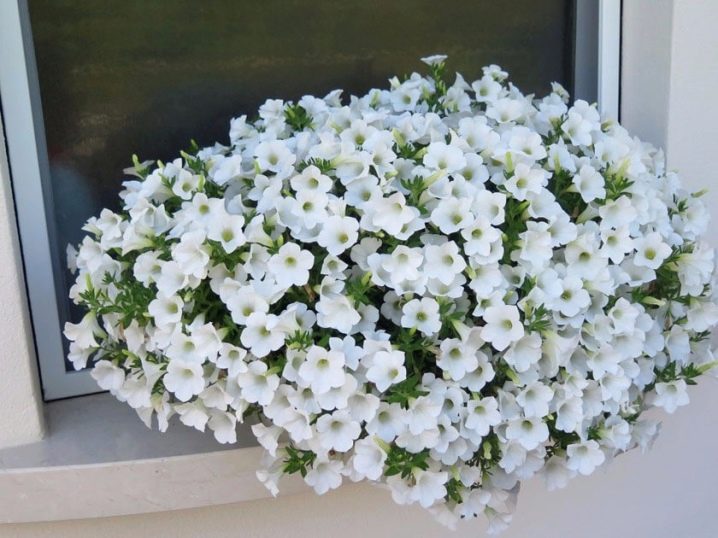
Shihi Purple. Showy purple flowers with wide petals densely cover the plant of this variety. This color will be appropriate in any part of the garden. It will perfectly complement the flowers in the neighborhood.

Double Blue Star. This variety is distinguished by lush flowers, somewhat reminiscent of carnations. The petals have an unusual dusty violet-blue tone.
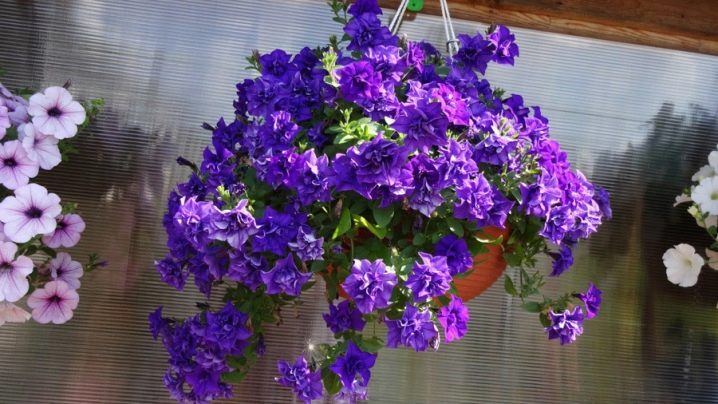
Lime. Named after the refreshing citrus, the variety features large star-shaped flowers. The bushes are powerful, lush. Each creamy white flower has a bright olive-colored center. From the depths of the bud in different directions, like rays, branchy lines diverge, adding visual texture to the petals.
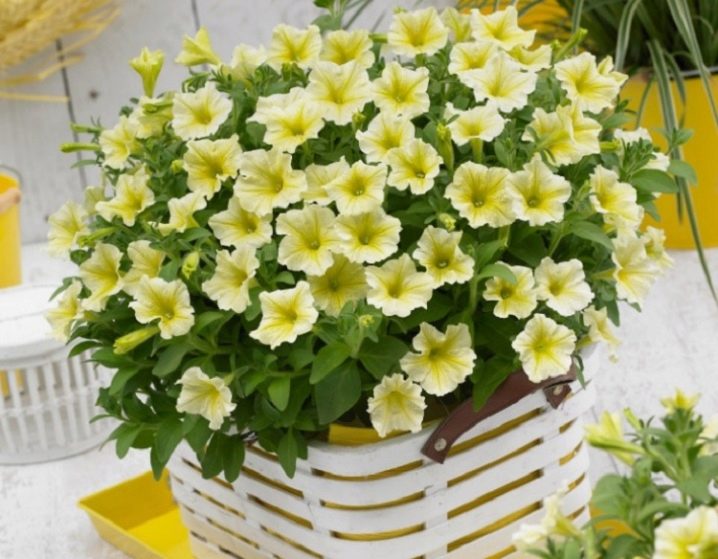
Snow. Another variety with a "telling" name. Luxurious flowers of pure white color with smooth rounded petals are striking in their beauty. A small yellow funnel in the middle gives the flowers a special expressiveness.
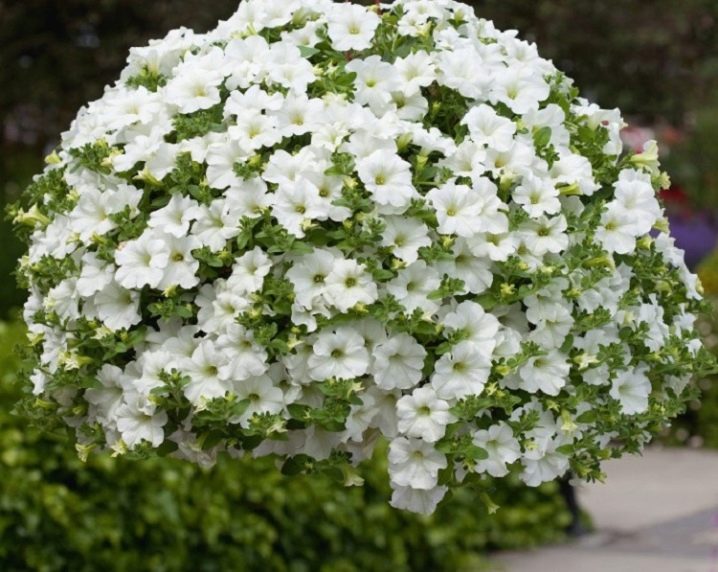
Hot Pink. This compact variety is characterized by large flowers that combine two shades. A pleasant pink tone is complemented by a dark crimson throat. Bright streaks run along the petals from the center of the flower, giving the flower expressiveness and volume.
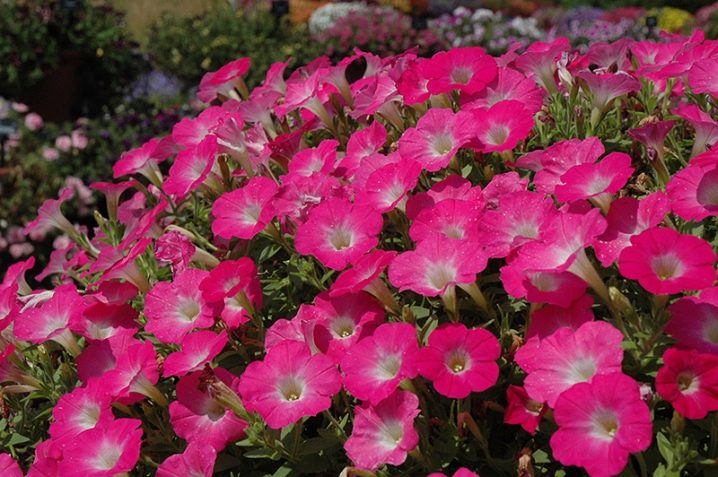
Giant Blue. Wavy flowers of a simple shape of a noble dark blue adorn a neat bush. One of the great options for connoisseurs of strict and laconic plants.

Double Lilac. This lush pink-purple charm, reminiscent of mini peonies, will impress any woman. Such a living decoration can easily create a romantic atmosphere and add charm to any corner of the garden.
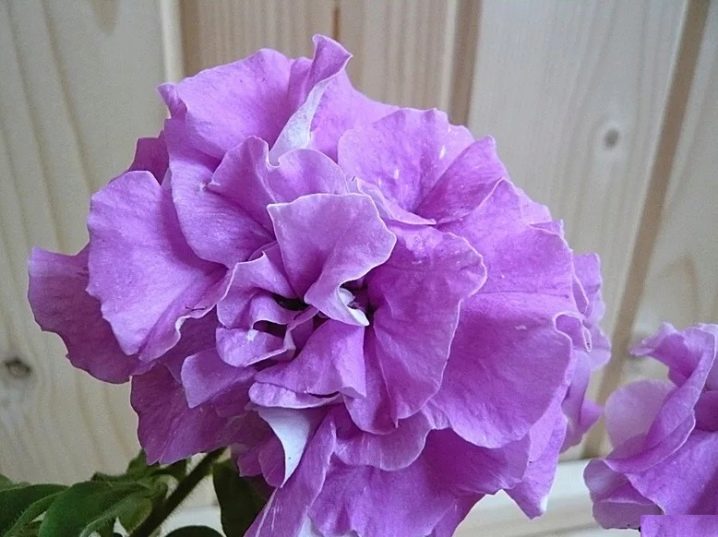
Burgundy. A powerful bush is decorated with large flowers of a refined wine shade, which explains the name of the variety. The culture pleases with flowering for several months. The plant is perfect for growing in hanging pots. It is also able to decorate any flower bed.

Table Salmon Vein. Neat flowers, consisting of five petals, have a light pink tint. The bright crimson center, from which the spectacular streaked rays radiate, makes the color bright and spectacular. Such a delicate plant is hard to miss.
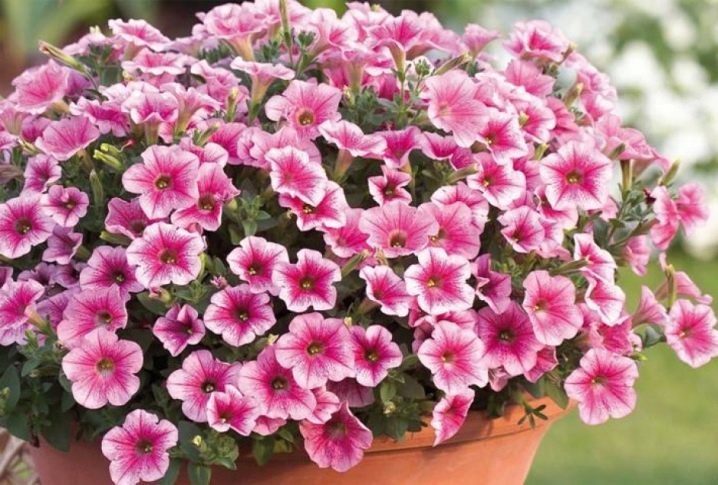
Blue Ocean. A branchy early flowering bush covered with flowers of the traditional form for petunias. The color of the petals is deep blue. Among other varieties of similar color, this variety stands out for the presence of a neat light circle in the center of each flower.

Silver Plantarium-2016
Silver was awarded to 12 new products of the floriculture market.
Sedge Everlight
The new Everlite sedge variety is the most compact in the Evercolor series. This beautiful plant is ideal for growing in pots and containers, but also thrives outdoors. This sedge is hardy and tolerates temperatures down to –25 ° C.
The plant breeder is the Irish company Fitzgerald Nurseries Ltd.
Action Yuki Cherry Blossom
Breeders call action by Yuki Cherry Blossom (Yuki Cherry Blossom) is a real “floricultural breakthrough”. She is surprisingly winter-hardy, unpretentious and, with all this, fantastically beautiful.
This small shrub, only 60 cm tall, is perfect for low curbs and patio containers.
The action by Yuki Cherry Blossom is the result of the work of the Dutch company Valkplant BV.
Foxglove Takfoplogo
The foxglove with the hard-to-pronounce name Takfoplgo conquers with a juicy, catchy golden-plum color of inflorescences.
This flower is a hybrid of foxglove purple and foxglove canary. The variety was bred by the Dutch breeder Martin van der Sar.
Geranium Jolly Jewel
Geranium ash Jolly Jewel - a series of varieties from the company "Compass Plants B.V." in the Netherlands.
This flower is winter-hardy, not afraid of diseases and pests, it grows quickly and pleases with flowering from April to September. The height of the bushes is 10-12 cm.
The series includes varieties with different flower colors: hot pink Jolly Jewel Hot Pink, Jolly Jewel Purple, Jolly Jewel Night, salmon Jolly Jewel Salmon Salmon, fuchsia with a silver spot at the base of the Jolly Jewel Silver.
Hebe Discovery
Hebe varieties Discovery (Discovery) - a miniature ornamental shrub of the plantain family. Its maximum height reaches 20 cm.
This plant is thermophilic and does not tolerate frost, therefore in cool climates it is grown mainly in containers. The purple flowers make the Discovery Chebe a desirable plant for patios and balconies.
Clematis Taiga
Perhaps it would not be a strong exaggeration to call Clematis Taiga the most spectacular novelty of the exhibition. The flowers of this decorative vine have a lemon-purple color, which is quite usual for their type, but their shape is striking. At first glance, it is hard to believe that this bizarre terry inflorescence is real.
Clematis Taiga blooms from June to September, is not afraid of partial shade, hardy, grows up to 2-3 m in length.
Geichera Rex Red
Geichera Rex Red (Rex Red) - the result of the work of Polish breeders of the Vitroflora company.
Plants of the new variety are attractive with red-purple foliage and delicate pink flowers. The strong point of this Heuchera is the long bloom throughout the summer.
Hibiscus Magenta Chiffon
Magenta Chiffon is the youngest variety of Syrian hibiscus, which was introduced just a few weeks ago. We have already talked about the unusual story of the emergence of a series of hibiscus called Chiffon.
Read more about the characteristics of this English cultivar and its "biography" in our article: The youngest variety of hibiscus - Magenta Chiffon.
Perovskia Denim-n-Lace
Perovskia swan-leaved, or Russian sage, varieties Denim'n'Lace is a tall, sprawling shrub with lilac-blue flowers. It is bred by German breeders from Cultivaris GmbH.
Hydrangea Pastel Green
Hydrangea paniculata varieties Pastel Green (Rencolor) series - the creation of the French grower Jean Reno, bred for the company "SAPHO".
The main advantage of this shrub is the change in color of the petals during the season.
Meet the new variety of panicle hydrangea - Pastel Green
In the family of hydrangeas - replenishment!
Bubbles Little Joker
Another silver medalist of Plantarium-2016 is the Little Joker cultivar from the Dutch nursery Hoogenraad.
This ornamental shrub can withstand frosts down to –30 ° C. It is quite compact - up to 50 cm in height and up to 30 cm in width, so it can be grown in containers if desired.
Sedum Jade Taffet
Sedum hybrid Jade Tuffet - "brother" of the gold medalist Plantarium-2016 Sedoro Blue Elf in the Sun Sparkler series. The breeder of this novelty is the same Chris Hansen from the American company Garden Solutions. Well, this year the florist is really lucky!
Read more: Types of stonecrops - photo, names and popular varieties


